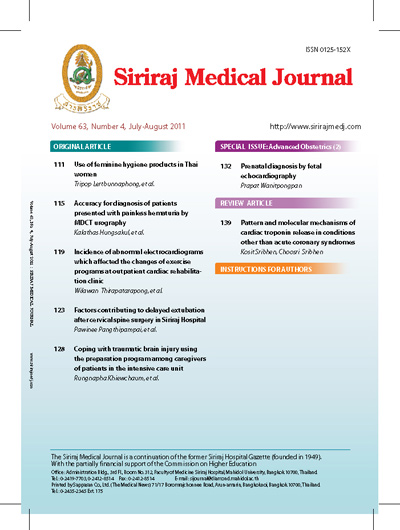Incidence of Abnormal Electrocardiograms Which Affected the Changes of Exercise Programs at Outpatient Cardiac Rehabilitation Clinic
Keywords:
Incidence; abnormal electrocardiogram; exercise program; cardiac rehabilitationAbstract
Objective: The primary purpose of the study was to determine the incidence of abnormal electrocardiograms (ECGs) which
affected the changes of exercise programs. The secondary purpose was to study types of ECG abnormality and the time of
detecting the abnormality.
Methods: The study was retrospective design. The studied population was selected from the followed up patients at our outpatient
cardiac rehabilitation clinic from October 1, 2008 to May 31, 2009. The inclusion criteria were patients who had to follow up
at our outpatient cardiac rehabilitation clinic and were monitored for ECG telemetry. The medical and ECG telemetry records
of the patients were reviewed. The incidence of abnormal ECGs was reported as the percentage of patients with abnormal
ECGs. The patients with abnormal ECGs were classified as the ECG changing group and those without abnormal ECGs were
classified as the non-ECG changing group. The comparison of both groups was performed by Chi-square test for categorical
data and the independent samples t-test for the quantitative data. The median survival time was carefully estimated by Kaplan-
Meier method of Survival Analysis. The factors associated with time of detecting abnormal ECGs were analyzed by using
Cox proportional hazards model. The data analysis was performed with statistical significant difference of the p-value < 0.05.
Results: Five hundred and forty patients, 378 males and 162 females, were enrolled. There were 151 from 540 patients (28%)
in the ECG changing group and 389 patients (72%) in the non-ECG changing group. The comparison between two groups
indicated that there were no significant differences regarding gender, age, body mass index, diseases and co-morbidities (such
as coronary artery disease, cerebrovascular disease, diabetes mellitus, hypertension, dyslipidemia and chronic obstructive lung
disease), left ventricular ejection fraction and status of cardiac surgery. The two most common types of ECG abnormality in
the ECG changing group were tachyarrhythmia and bradyarrhythmia, respectively. The Cox proportional hazards model revealed
that there was no factor associated with time of detecting abnormal ECGs. From the Kaplan-Meier method of Survival Analysis,
the median survival time of detecting abnormal ECGs was 61 months (95% CI: 47.6, 74.9).
Conclusion: The incidence of abnormal ECGs which affected the changes of exercise programs in our outpatient cardiac
rehabilitation clinic was 28%. The most common type of abnormality was tachyarrhythmia. The median survival time for
detecting abnormal ECGs was 61 months after cardiac hospital discharge. There was no associated factor with the time of
detecting abnormal ECGs.
References
ML. Exercise standards: a statement for healthcare professionals from the
American Heart Association Writing Group. Circulation. 1995 Jan 15;91
(2):580-615.
2. Curry JP, Hanson CW, Russell MW, Hanna C, Devine G, Ochroch A.
The use and effectiveness of electrocardiographic telemetry monitoring in
a community hospital general care setting. Anesth Analg. 2003 Nov;97
(5):1483-7.
3. Fletcher GF, Balady GJ, Amsterdam EA, Chaitman B, Eckel R, Fleg J,
et al. Exercise standards for testing and training: a statement for healthcare
professionals from the American heart association. Circulation. 2001
Oct 2;104(14):1694-740.
4. American College of Cardiology/American Heart Association. ACC/AHA
2002 guideline update for exercise testing. J Am Coll Cardiol. 2002;40:
1531.
5. American College of Sports Medicine. ACSMัs guidelines for exercise
testing and prescription. 7th ed. Baltimore (MD): Lippincott Williams &
Wilkins; 2006.
6. Kavanagh T. Cardiac rehabilitation: Canada. In: Perk J, Mathes P, Gohlke
H, Monpere C, Hellemans I, McGee H, Sellier P, Saner H, editors. Cardiovascular
prevention and rehabilitation. London: Springer; 2007. p. 37-40.
7. Henriques MN, Ivonye CC, Jamched U, Kamuguisha LK, Olejeme KA,
Onwuanyi AE. Is telemetry overused? Is it as helpful as though? Cleve
Clin J Med. 2009 Jun;76(6):368-72.
8. Drew BJ, Scheinman MM, Evans GT Jr. Comparison of a vectrocardiographically
derived 12-lead electrocardiogram with the conventional electrocardiogram
during wide QRS complex tachycardia and its potential
application for continuous bedside monitoring. Am J Cardiol. 1992 Mar
1;69(6):612-8.
9. Denes P. The importance of derived 12-lead electrocardiography in the
interpretation of arrhythmias detected by Holter recording. Am Heart J.
1992 Oct;124(4):905-11.
10. Drew BJ, Adams MG, Pelter MM, Wung SF. ST-segment monitoring
with a derived 12-lead electrocardiogram is superior to routine CCU monitoring.
Am J Crit Care. 1996 May;5(3):198-206.
11. Drew BJ, Adams MG, Pelter MM, Wung SF, Caldwell MA. Comparison
of standard and derived 12-lead electrocardiograms for diagnosis of coronary
angioplasty induced myocardial ischemia. Am J Cardiol. 1997
Mar 1;79(5):639-44.
12. Drew BJ, Pelter MM, Wung SF, Adams MG, Taylor C, Evans GT, et al.
Accuracy of the EASI 12-lead electrocardiogram compared to the standard
12-lead electrocardiogram for diagnosing multiple cardiac abnormalities.
J Electrocardiol. 1999;32 Suppl:38-47.
13. Adamopoulos S, Fountoulaki K, Parissis J. Exercise testing in coronary
heart disease. In: Perk J, Mathes P, Gohlke H, Monpere C, Hellemans I,
McGee H, Sellier P, Saner H, editors. Cardiovascular prevention and
rehabilitation. London: Springer; 2007. p. 88-98.
Downloads
Published
How to Cite
Issue
Section
License
Authors who publish with this journal agree to the following conditions:
Copyright Transfer
In submitting a manuscript, the authors acknowledge that the work will become the copyrighted property of Siriraj Medical Journal upon publication.
License
Articles are licensed under a Creative Commons Attribution-NonCommercial-NoDerivatives 4.0 International License (CC BY-NC-ND 4.0). This license allows for the sharing of the work for non-commercial purposes with proper attribution to the authors and the journal. However, it does not permit modifications or the creation of derivative works.
Sharing and Access
Authors are encouraged to share their article on their personal or institutional websites and through other non-commercial platforms. Doing so can increase readership and citations.











